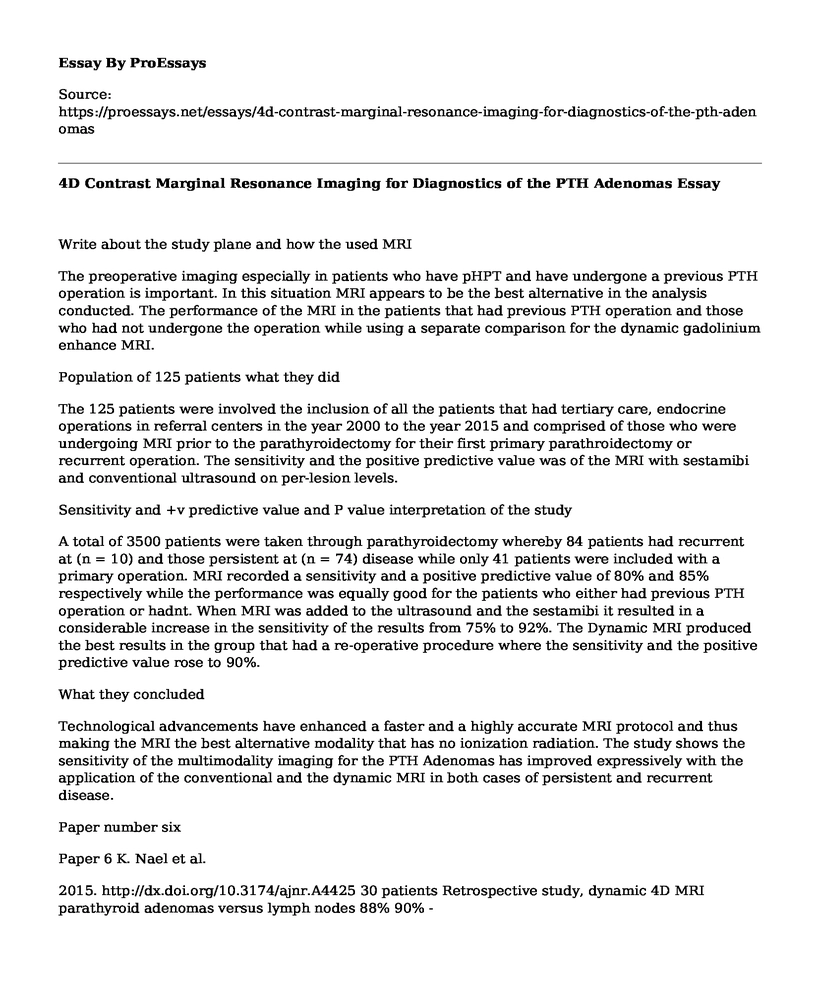Write about the study plane and how the used MRI
The preoperative imaging especially in patients who have pHPT and have undergone a previous PTH operation is important. In this situation MRI appears to be the best alternative in the analysis conducted. The performance of the MRI in the patients that had previous PTH operation and those who had not undergone the operation while using a separate comparison for the dynamic gadolinium enhance MRI.
Population of 125 patients what they did
The 125 patients were involved the inclusion of all the patients that had tertiary care, endocrine operations in referral centers in the year 2000 to the year 2015 and comprised of those who were undergoing MRI prior to the parathyroidectomy for their first primary parathroidectomy or recurrent operation. The sensitivity and the positive predictive value was of the MRI with sestamibi and conventional ultrasound on per-lesion levels.
Sensitivity and +v predictive value and P value interpretation of the study
A total of 3500 patients were taken through parathyroidectomy whereby 84 patients had recurrent at (n = 10) and those persistent at (n = 74) disease while only 41 patients were included with a primary operation. MRI recorded a sensitivity and a positive predictive value of 80% and 85% respectively while the performance was equally good for the patients who either had previous PTH operation or hadnt. When MRI was added to the ultrasound and the sestamibi it resulted in a considerable increase in the sensitivity of the results from 75% to 92%. The Dynamic MRI produced the best results in the group that had a re-operative procedure where the sensitivity and the positive predictive value rose to 90%.
What they concluded
Technological advancements have enhanced a faster and a highly accurate MRI protocol and thus making the MRI the best alternative modality that has no ionization radiation. The study shows the sensitivity of the multimodality imaging for the PTH Adenomas has improved expressively with the application of the conventional and the dynamic MRI in both cases of persistent and recurrent disease.
Paper number six
Paper 6 K. Nael et al.
2015. http://dx.doi.org/10.3174/ajnr.A4425 30 patients Retrospective study, dynamic 4D MRI parathyroid adenomas versus lymph nodes 88% 90% -
parathyroid adenomas versus thyroid tissue 91% 95% -
4 main point to be included
Write about the study plane and how they used MRI and how they use the wash in and wash out and the time to peak
The parathyroid adenomas has a hypervascular nature that can be explored using the proper dynamic MRI to minimize the targeted lesions during surgical explorations. This study was conducted with the aim of establishing Magnetic Resonance perfusion specifications of the PTH adenomas and be in a position to differentiate them from their imitators for instance the cervical lymph nodes and the subjacent thyroid tissue.
The population of 30 patients what they did
Pre-operative temporal and spatial high resolution dynamic 4D contrast enhanced Marginal Resonance Imaging in the 30 patients who have provable PTH adenomas which was evaluated in a retrospective manner. With the use of co-registered images, the ROIs were placed over the thyroid gland, PTH adenomas, and cervical lymph nodes so as to obtain the peak enhancement, wash-in and wash-out in every patient. The data was analyzed through a logistic regression and variance analysis.
Sensitivity and specificity interpretation of the study
PTH adenomas indicated considerably at (P< .05) time to peak faster, high washout in comparison to the cervical lymph nodes and con-currently P < .05 higher enhancement peak, faster time to peak, and higher washout and wash in in comparison to the thyroid tissue. The logistic regression analysis showed that there was a significant contribution from the time-to-peak at P = .02 while that of the wash-in at P = .03 and for the wash out at P=.008 to grant the best diagnostic accuracy in a manner of combination of the time-of-peak or the wash-in or during the wash-out in differentiating the parathyroid adenomas versus the lymph nodes. The area under the curve at 0.97; sensitivity 88.2%/91% in the process of distinguishing the PTH adenomas vs. the thyroid tissue (curve area 0.97; sensitivity at 91.5%/95.6% )
What they concluded
The conclusion was that the Dynamic 4D contrast MRI can be utilized in the exploitation of the hypervascular ature of the PTH adenoma. The Multiparametric Magnetic Resonance perfusion can distinguish the PTH adenomas from the lymph nodes and the subjacent thyroid tissue in a perfect diagnostic accuracy of 96.5%
Cite this page
4D Contrast Marginal Resonance Imaging for Diagnostics of the PTH Adenomas. (2021, Mar 19). Retrieved from https://proessays.net/essays/4d-contrast-marginal-resonance-imaging-for-diagnostics-of-the-pth-adenomas
If you are the original author of this essay and no longer wish to have it published on the ProEssays website, please click below to request its removal:
- How Best Can We Handle the Opioid Crisis?
- How to Get Affordable Viagra Paper Example
- Essay Example on Major Practice Patterns for Controlling Dyslipidemia
- Research Paper on Global Cancer: A Growing Concern
- Research Paper on Malnutrition: Devastating Effects from Birth to Adulthood
- Essay on Smoking Ban in Public Housing Violates Rights: HUD Authority Questioned
- Essay Sample on Prompt Response to OSHA Citations & Penalties







